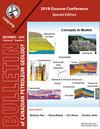阿尔伯塔省Saleski Grosmont组沥青蒸汽先导油藏地质
Q3 Earth and Planetary Sciences
引用次数: 3
摘要
格罗斯蒙特组是世界上最大的沥青矿床之一,估计资源量为645亿立方米(4060亿桶)。Grosmont组包含4个叠合的碳酸盐岩单元。最上面的两个,即格罗斯蒙特C和D,包含了大部分的格罗斯蒙特沥青资源。Grosmont C储层厚度为20 m,以洞状白云岩为主,平均孔隙度为18.6%。上覆32 m厚的Grosmont D段平均孔隙度为24.3%,主要储集相为白云岩角砾岩。沥青和水的饱和度在整个储层中是可变的,需要岩心分析或核磁共振测井等外来测井工具才能准确测定。通过对Grosmont储层沥青饱和度的进一步了解,发现了Grosmont d区内的贫沥青层。通过使用放射性示踪测井,确定该层是主要的钻井液盗窃层。Laricina Energy Ltd.和Osum Corp.正在Grosmont C和d区的26twp 85 Rge 19W4M区块进行循环蒸汽辅助重力排水(SAGD)试验,截至2015年2月,该试验已生产了79500立方米(50万桶)沥青。本文章由计算机程序翻译,如有差异,请以英文原文为准。
Reservoir geology of the Grosmont Formation Bitumen Steam Pilot, Saleski, Alberta
Abstract The Grosmont Formation, with an estimated resource of 64.5 billion m3 (406 billion bbl), is one of the largest bitumen deposits in the world. The Grosmont Formation contains four stacked carbonate units. The uppermost two, the Grosmont C and D, contain the bulk of the Grosmont bitumen resource. The Grosmont C reservoir interval is 20 m thick and consists mainly of vuggy dolomite with an average porosity of 18.6%. The overlying 32 m thick Grosmont D has an average porosity of 24.3% and its main reservoir facies is dolomite breccia. Bitumen and water saturations are variable throughout the reservoir and require either core analysis or exotic logging tools such as nuclear magnetic resonance logging for accurate determination. One outcome of the improved understanding of bitumen saturations within the Grosmont reservoirs was the identification of a lean bitumen zone within the Grosmont D. Through the use of radioactive tracer logs, it was determined that this zone is a major drilling fluids thief zone. Laricina Energy Ltd. and Osum Corp. are conducting a cyclic steam assisted gravity drainage (SAGD) pilot at Section 26 Twp 85 Rge 19W4M using horizontal wells in both the Grosmont C and D. The pilot has produced 79 500 m3 (500 000 bbl) of bitumen up to February, 2015.
求助全文
通过发布文献求助,成功后即可免费获取论文全文。
去求助
来源期刊

Bullentin of Canadian Petroleum Geology
Earth and Planetary Sciences-Geochemistry and Petrology
CiteScore
2.50
自引率
0.00%
发文量
0
期刊介绍:
The Bulletin of Canadian Petroleum Geology is a peer-reviewed scientific journal published four times a year. Founded in 1953, the BCPG aims to be the journal of record for papers dealing with all aspects of petroleum geology, broadly conceived, with a particularly (though not exclusively) Canadian focus. International submissions are encouraged, especially where a connection can be made to Canadian examples.
 求助内容:
求助内容: 应助结果提醒方式:
应助结果提醒方式:


